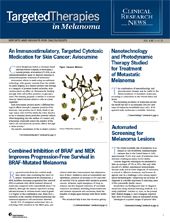Automated Screening for Melanoma Lesions
Researchers are finding new ways to diagnose melanoma using machine learning methods.
The overall mortality rate of melanoma is es- timated at 14% worldwide. Epidemiologists estimate that in the United States in 2013, approximately 77,000 new cases of melanoma were detected, resulting in nearly 10,000 deaths.
Current diagnosis techniques are estimated to have an accuracy of 75% to 85%but only with the aid of a skilled, experienced dermatologist. Because early and accurate diagnosis of melanoma is critical to effective treatment, and because diagnosis may be a challenge—even among experienced dermatologists—improving the accuracy of diagnosis is critically important in detecting cases of this potentially deadly cancer.
Researchers are finding new ways to diagnose melanoma using machine learning methods. In a study published October 13, 2014, in the journalBMC Medical Imaging, Li and colleagues reported high rates of accuracy using an automated system.
Investigators acquired images of patients’ skin lesions, processed those images using computer algorithms, and classified moles into various categories with the aid of a neural network. Of 187 images collected, including 19 from patients with malignant melanoma and 168 patients with benign lesions, investigators used a spectroscopic device and specialized filters to classify potential lesions.
Of several different computer learning networks tested, a network known as the naïve Bayes’ classifier was the most effective in achieving diagnostic accuracy. In 89% of cases, the Bayes’ classifier separated cases of true melanoma from cases of benign skin lesions with 89% sensitivity and 89% specificity.1
Other researchers are working on different methods for skin cancer screening. For example, The Optical Society, in collaboration with Duke University researchers, developed a tool known as the whole-body dermascope. The dermascope is a chamber containing 36 cameras that produces highly accurate, high-resolution images of the full body surface. According to cocreator Daniel Marks, “The camera is designed to find lesions potentially indicating skin cancers on patients at an earlier stage than current skin examination techniques.”
Like Li and colleagues, Marks said he hopes to improve on the current, relatively unreliable techniques of expert inspection. According to Marks, the system has the advantage of enabling high- resolution imaging of the entire bodyrather than high-resolution examination of a small portion of the body, which is already available with current techniques.
Although dermascope technology has not yet been used in a clinical setting, it is possible that a combination of the dermascope to identify suspicious lesions over time and the neural network- based recognition system may enable primary care physicians to both identify more cases of melanoma, and potentially initiate effective treatment earlier.
With the availability of new agents for melanoma, including the targeted therapies ipilimumab (Yervoy) and nivolumab (Opdivo), earlier treatment of melanoma with effective therapies may reduce mortality rates through earlier screening, giving patients the opportunity for potentially higher cure rates and more treatment options.2
However, as with any screening technology, the risk of false-positive diagnoses and overdiagnosis of cancers is constant. Carefully weighing the risks and benefits of screening in a future trial will be critical to implementation of this new technology.3
References
- Li L, Zhang Q, Ding Y, Jiang H, Thiers BH, Wang JZ. Automatic diagnosis of melanoma using machine learning methods on a spectroscopic system.BMC Med Imaging.2014;14(1):36.
- The skin cancer selfie [press release]. Washington, DC: Optical Society of America; 2014. http://www.osa.org/en- us/about_osa/newsroom/news_releases/2014/the_skin_ cancer_selfie/. Accessed October 2014.
- To screen or not to screen? When screening for lung cancer causes harm and how physicians can avoid overscreening. Am J Manag Care. http://www.ajmc.com/ conferences/chest-2014/To-Screen-or-Not-to-Screen- When-Screening-for-Lung-Cancer-Causes-Harm-and- How-Physicians-Can-Avoid-Overscreening. Accessed October 2014.
